Environmental Disclosure in Annual Report of Energy Companies
This study analyzes and evaluate various aspects related to the environmental disclosure for the energy companies of NZ and India to examine the follow up procedures of GRI Guidelines and GRI Standards subset of Energy and Emission.
32 Pages8623 Words98 Views
Added on 2023-06-11
About This Document
This article discusses the importance of environmental disclosure in the annual reports of energy companies. It covers the impact of carbon emissions and energy on the environment, the Global Reporting Initiative and its role in aiding companies to report their effects on climate change, corruption and human rights. The article also includes a literature review and research methodology. Course code and college/university not mentioned.
Environmental Disclosure in Annual Report of Energy Companies
This study analyzes and evaluate various aspects related to the environmental disclosure for the energy companies of NZ and India to examine the follow up procedures of GRI Guidelines and GRI Standards subset of Energy and Emission.
Added on 2023-06-11
ShareRelated Documents
[Author Name(s), First M. Last, Omit Titles and Degrees]
[Institutional Affiliation(s)]
[Institutional Affiliation(s)]

Contents
CHAPTER 1: INTRODUCTION.............................................................................................................................. 3
Environmental Disclosure and its Importance........................................................................................3
Global Reporting Initiative................................................................................................................................ 5
Carbon Emissions and Energy.........................................................................................................................5
CHAPTER 2: LITERATURE REVIEW..................................................................................................................7
CHAPTER 3: RESEARCH METHODOLOGY................................................................................................... 17
Introduction.......................................................................................................................................................... 17
Research Methodology.....................................................................................................................................18
Research Methods and Data Sources.........................................................................................................18
Advantages of Quantitative Research........................................................................................................20
Disadvantages of Quantative Research.....................................................................................................20
Rationale for Research Methodology........................................................................................................ 21
CHAPTER 4: RESULTS AND DISCUSSION.....................................................................................................22
Descriptive analysis...........................................................................................................................................22
Scores of carbon emission disclosures by various industries........................................................24
Regression analysis for the disclosures of carbon emissions.........................................................26
Conclusion.................................................................................................................................................................. 28
References.................................................................................................................................................................. 29
CHAPTER 1: INTRODUCTION.............................................................................................................................. 3
Environmental Disclosure and its Importance........................................................................................3
Global Reporting Initiative................................................................................................................................ 5
Carbon Emissions and Energy.........................................................................................................................5
CHAPTER 2: LITERATURE REVIEW..................................................................................................................7
CHAPTER 3: RESEARCH METHODOLOGY................................................................................................... 17
Introduction.......................................................................................................................................................... 17
Research Methodology.....................................................................................................................................18
Research Methods and Data Sources.........................................................................................................18
Advantages of Quantitative Research........................................................................................................20
Disadvantages of Quantative Research.....................................................................................................20
Rationale for Research Methodology........................................................................................................ 21
CHAPTER 4: RESULTS AND DISCUSSION.....................................................................................................22
Descriptive analysis...........................................................................................................................................22
Scores of carbon emission disclosures by various industries........................................................24
Regression analysis for the disclosures of carbon emissions.........................................................26
Conclusion.................................................................................................................................................................. 28
References.................................................................................................................................................................. 29

CHAPTER 1: INTRODUCTION
Environmental Disclosure and its Importance
With time, the engagement of a company in CSR issues develops and hence the degree to which
it is in a position to disclose its information. Past research has indicated gradual increases in the
disclosure of CSR in the annual reports of companies. Environmental reporting was first studied
as a segment of social reporting. Different studies have been done regarding corporate socials
reporting as well as environmental reporting. Environmental disclosure can thus be defined as
the disclosing of the information of a company regarding its environmental practices. Such
disclosure may be of benefit to the company and its reputation as compared to the actual
environmental firmly performance as has been proven by a recent study (Haque & Deegan
2010).
The non-anticipated benefit of disclosing information may help lower the incentives of a
company toward improving the environmental performance in the times to come. From the
various analyses done by researchers, it has been demonstrated that the more information is
disclosed by companies with regard to their sustainable practices, the better they were perceived
to be environmentally friendly even under circumstances that the data presented proved
otherwise (Moroney, Windsor & Aw 2012).
With the current business information technology such as the internet accessible equipment and
the tools, the industrial environmental tools of the management, the policies and the legislation
that govern the environmental information has been designed. The information that is obtained
from the environmental information system has been of help to the managers. It has helped the
managers to identify the potential risks, the incurred costs of the structure including the
investment that needs the environmental challenge to be faced by the firm itself.
Environmental Disclosure and its Importance
With time, the engagement of a company in CSR issues develops and hence the degree to which
it is in a position to disclose its information. Past research has indicated gradual increases in the
disclosure of CSR in the annual reports of companies. Environmental reporting was first studied
as a segment of social reporting. Different studies have been done regarding corporate socials
reporting as well as environmental reporting. Environmental disclosure can thus be defined as
the disclosing of the information of a company regarding its environmental practices. Such
disclosure may be of benefit to the company and its reputation as compared to the actual
environmental firmly performance as has been proven by a recent study (Haque & Deegan
2010).
The non-anticipated benefit of disclosing information may help lower the incentives of a
company toward improving the environmental performance in the times to come. From the
various analyses done by researchers, it has been demonstrated that the more information is
disclosed by companies with regard to their sustainable practices, the better they were perceived
to be environmentally friendly even under circumstances that the data presented proved
otherwise (Moroney, Windsor & Aw 2012).
With the current business information technology such as the internet accessible equipment and
the tools, the industrial environmental tools of the management, the policies and the legislation
that govern the environmental information has been designed. The information that is obtained
from the environmental information system has been of help to the managers. It has helped the
managers to identify the potential risks, the incurred costs of the structure including the
investment that needs the environmental challenge to be faced by the firm itself.
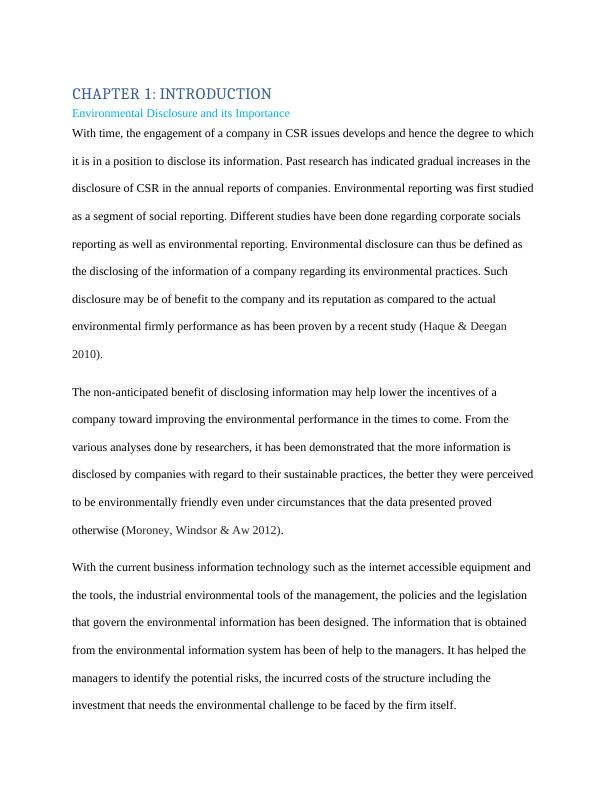
The surrounding or the environment may not only be protected by those strict economic
outcomes or the results. It is important to note that the environmental information like
accounting of the environment together with the reporting may be done by the individuals on the
voluntary basis. This is usually made possible when the concern is directed to the natural
environment (Lodhia & Martin 2011). The basis of very many environmental researches has
been the use of the information given by the international organization for the standardization
(ISO). In order to comply with these demands or to meet them effectively, the corporate reports
on the annual basis that is commonly referred to as the annual reports AR) besides the
accounting information are considered very important aspect. Such information should be
communicated to the stakeholders of the firm.
Most scholars recognize the tricky nature of this particular method. The concept that aims at the
sustainability of the development will always appear to defy those steps or the different measures
that exist within the financial accounting economic based analysis. These models or the analysis
have taken the center in the determination of the today’s success of most business. The concept
argues that the concept of the economic development and the protection of the natural
environment will always be treated as a single entity and not as separate processes (Beck,
Campbell & Shrives 2010). The used methodology is taken to be qualitative research just to
understand the meaning that the firms and the managers have already been pointed out and
among the key issues highlighted may include the environmental disclosure(ED), how the
individuals exploit their knowledge about the natural environment and the experiences that they
have. The quantitative research will always help in the identification of the concepts, the
comparable metrics and to make the analysis of the statistical information to be successful.
outcomes or the results. It is important to note that the environmental information like
accounting of the environment together with the reporting may be done by the individuals on the
voluntary basis. This is usually made possible when the concern is directed to the natural
environment (Lodhia & Martin 2011). The basis of very many environmental researches has
been the use of the information given by the international organization for the standardization
(ISO). In order to comply with these demands or to meet them effectively, the corporate reports
on the annual basis that is commonly referred to as the annual reports AR) besides the
accounting information are considered very important aspect. Such information should be
communicated to the stakeholders of the firm.
Most scholars recognize the tricky nature of this particular method. The concept that aims at the
sustainability of the development will always appear to defy those steps or the different measures
that exist within the financial accounting economic based analysis. These models or the analysis
have taken the center in the determination of the today’s success of most business. The concept
argues that the concept of the economic development and the protection of the natural
environment will always be treated as a single entity and not as separate processes (Beck,
Campbell & Shrives 2010). The used methodology is taken to be qualitative research just to
understand the meaning that the firms and the managers have already been pointed out and
among the key issues highlighted may include the environmental disclosure(ED), how the
individuals exploit their knowledge about the natural environment and the experiences that they
have. The quantitative research will always help in the identification of the concepts, the
comparable metrics and to make the analysis of the statistical information to be successful.
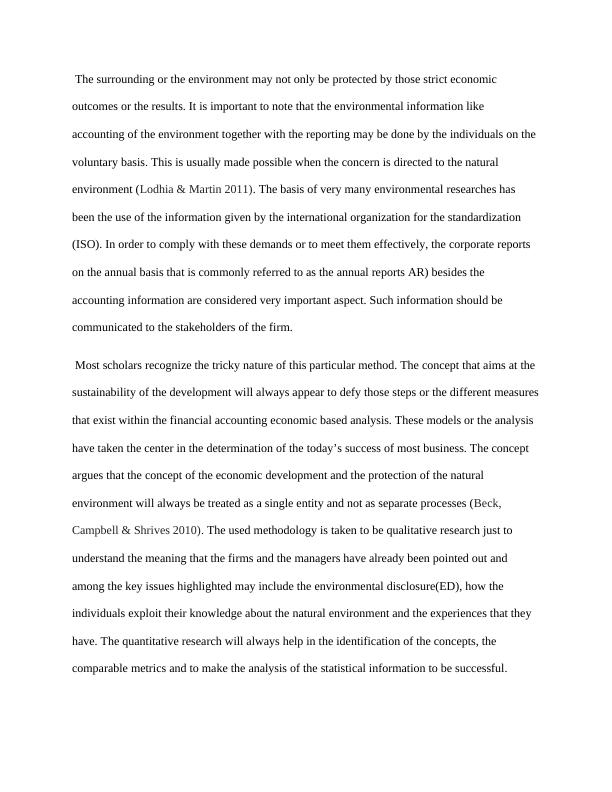
Various authors have talked about the environmental disclosure as the best approach in order to
tack the challenges. The authors have first discussed the literature review. The empirical analysis
can also be used in achieving the specific goals .The description of the process, the data
collection processes, hypotheses subjected to the proper testing and finally there is a presentation
that will include the data processing, the test of the hypotheses and getting the results.
Global Reporting Initiative
The Global Reporting Initiative, GRI, refers to a global independent organizations of stands that
aid business, governments an any other companies or organizations in comprehending and
communicating their effects on issues among them climate change, corruption and human rights.
Owing to the increasing pressure from the various groups of stakeholder for more transparency
on social, environmental and economic implications, most of the companies are forced to make
and produce sustainability reports (Beck, Campbell & Shrives 2010). The frame work of GRI is
suited in such a way that it aids the companies in the identification, collections and reporting of
such information in a manner that is clear, concise and comparable.
Carbon Emissions and Energy
The population of the country is relatively small though it is endowed with many resources that
are naturally occurring. The unfortunate thing about this country is that it cannot have sufficient
internally produced energy (Lodhia & Martin 2011). It is a net importer of the energy in the form
of the petroleum products .It important to note that the ratio of the renewable to non-renewable
has shown consistency since the year 1975.This ratio however showed a lot of decrease almost
by 60 per cent in the year 2014.The proportion of the non-renewable source has entirely relied on
the water flow in the period of years although the records are taken annually.
tack the challenges. The authors have first discussed the literature review. The empirical analysis
can also be used in achieving the specific goals .The description of the process, the data
collection processes, hypotheses subjected to the proper testing and finally there is a presentation
that will include the data processing, the test of the hypotheses and getting the results.
Global Reporting Initiative
The Global Reporting Initiative, GRI, refers to a global independent organizations of stands that
aid business, governments an any other companies or organizations in comprehending and
communicating their effects on issues among them climate change, corruption and human rights.
Owing to the increasing pressure from the various groups of stakeholder for more transparency
on social, environmental and economic implications, most of the companies are forced to make
and produce sustainability reports (Beck, Campbell & Shrives 2010). The frame work of GRI is
suited in such a way that it aids the companies in the identification, collections and reporting of
such information in a manner that is clear, concise and comparable.
Carbon Emissions and Energy
The population of the country is relatively small though it is endowed with many resources that
are naturally occurring. The unfortunate thing about this country is that it cannot have sufficient
internally produced energy (Lodhia & Martin 2011). It is a net importer of the energy in the form
of the petroleum products .It important to note that the ratio of the renewable to non-renewable
has shown consistency since the year 1975.This ratio however showed a lot of decrease almost
by 60 per cent in the year 2014.The proportion of the non-renewable source has entirely relied on
the water flow in the period of years although the records are taken annually.
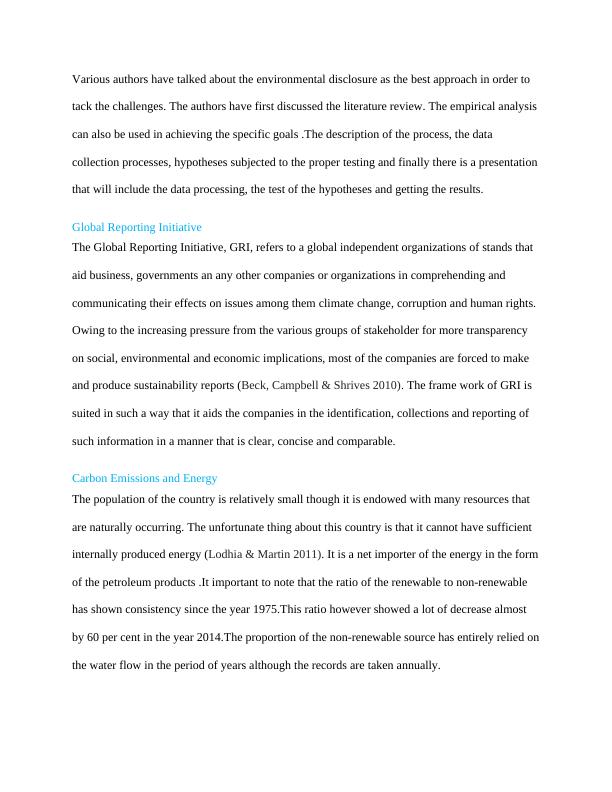
The most common energy supply sources incudes the coal, the oil gas, the waste gas, biofuel,
solar wood, hydro, geothermal, wind among many more.
The carbon emissions that have dominated the atmosphere of the New Zealand mainly come
from the combustion of the fossil fuels. These fuels are compounds of the carbon, hydrogen and
oxygen elements. When they undergo combustion, a lot of carbon dioxide gas is produced. In the
cases of the incomplete combustion, carbon monoxide is produced instead of the carbon dioxide.
The tremendous increase in the level of the gas can be associated with other activities a part from
the combustion in the identified area or sources (Hsieh 2012). The road vehicle emissions were
up to 37 per cent as indicated by the recent data or statistics. The manufacturing and the
construction industries had their emissions up to 43 per cent while the electricity only
contributed only 11 percentages of the total emissions of the carbon.
The result of this high increase in the level of carbon dioxide in the atmosphere is the increase
amount of the temperatures in this country. This has led to the melting of the glacier, production
of the acid rain whose scorching effects are transferred to the lives of the plants and the animals.
The overproduction of the sooty smoke is attributed to the respiratory tract diseases in the
animals and the reduced photosynthesis rates in the green plants. The net uptake of the carbon
dioxide through absorption in the water bodies and the forest has equally gone down and this has
just worsened the situation (Kaenzig et al. 2011).
The energy and the energy utilities in New Zealand vary from the electricity industry to the oil
and gas companies. The demand for this type of energy has gone so high and this has forced the
companies to explore the new areas whether in terms of technological possibility while applying
the engineering concepts (Lodhia & Martin 2011). There is a lot of the expectation that in the
solar wood, hydro, geothermal, wind among many more.
The carbon emissions that have dominated the atmosphere of the New Zealand mainly come
from the combustion of the fossil fuels. These fuels are compounds of the carbon, hydrogen and
oxygen elements. When they undergo combustion, a lot of carbon dioxide gas is produced. In the
cases of the incomplete combustion, carbon monoxide is produced instead of the carbon dioxide.
The tremendous increase in the level of the gas can be associated with other activities a part from
the combustion in the identified area or sources (Hsieh 2012). The road vehicle emissions were
up to 37 per cent as indicated by the recent data or statistics. The manufacturing and the
construction industries had their emissions up to 43 per cent while the electricity only
contributed only 11 percentages of the total emissions of the carbon.
The result of this high increase in the level of carbon dioxide in the atmosphere is the increase
amount of the temperatures in this country. This has led to the melting of the glacier, production
of the acid rain whose scorching effects are transferred to the lives of the plants and the animals.
The overproduction of the sooty smoke is attributed to the respiratory tract diseases in the
animals and the reduced photosynthesis rates in the green plants. The net uptake of the carbon
dioxide through absorption in the water bodies and the forest has equally gone down and this has
just worsened the situation (Kaenzig et al. 2011).
The energy and the energy utilities in New Zealand vary from the electricity industry to the oil
and gas companies. The demand for this type of energy has gone so high and this has forced the
companies to explore the new areas whether in terms of technological possibility while applying
the engineering concepts (Lodhia & Martin 2011). There is a lot of the expectation that in the

future this demand will be sufficiently met through increasing the mix of generation
technologies. The role of the electricity is expanding. It is even expected to be a lot with the
increase in the use of the modern cars that uses the electricity.
CHAPTER 2: LITERATURE REVIEW
Climate change has remained a significantly growing issue for numerous decades especially in
the developed countries even though only a few on climate changes have been done in the
developing countries. There is thus a need to encourage and bring on board both the private and
the public sectors urgent and set in place action on both the adaptation and mitigation measures
towards the menace (Hooks & Van 2011). Such an action will have an impact as well as
stimulate the market that would be important in the generation of more investments that are
aimed at the achievement of sustainable energy in the times to come. The effective and most
reliable tool in the combat of climate change is through carbon pricing which would translate the
emission of carbon into a cost that a government a company or business as well as the
accompanying customers are in a position to incorporate into the decisions of reinvestments.
This may also be perceived as sustainable finance.
Researchers and scholars have mentioned that there is an urgent for strong and consolidated
public pressure in the world to mitigate the GHC emissions in as much as there are significant
variations in the GHC mitigations regulatory requirements among different countries. This
illustrates that there could be variations in the policy and regulations between the developing and
developed countries (Cowan & Deegan 2011).
(King, Fogelberg, Hoballah, Malan 2016) as well discusses this in which they say that
sustainability reporting has formed an integrals aspect of global actions which should take into
consideration environmental and social sciences. Owing to this, need to take into account the
technologies. The role of the electricity is expanding. It is even expected to be a lot with the
increase in the use of the modern cars that uses the electricity.
CHAPTER 2: LITERATURE REVIEW
Climate change has remained a significantly growing issue for numerous decades especially in
the developed countries even though only a few on climate changes have been done in the
developing countries. There is thus a need to encourage and bring on board both the private and
the public sectors urgent and set in place action on both the adaptation and mitigation measures
towards the menace (Hooks & Van 2011). Such an action will have an impact as well as
stimulate the market that would be important in the generation of more investments that are
aimed at the achievement of sustainable energy in the times to come. The effective and most
reliable tool in the combat of climate change is through carbon pricing which would translate the
emission of carbon into a cost that a government a company or business as well as the
accompanying customers are in a position to incorporate into the decisions of reinvestments.
This may also be perceived as sustainable finance.
Researchers and scholars have mentioned that there is an urgent for strong and consolidated
public pressure in the world to mitigate the GHC emissions in as much as there are significant
variations in the GHC mitigations regulatory requirements among different countries. This
illustrates that there could be variations in the policy and regulations between the developing and
developed countries (Cowan & Deegan 2011).
(King, Fogelberg, Hoballah, Malan 2016) as well discusses this in which they say that
sustainability reporting has formed an integrals aspect of global actions which should take into
consideration environmental and social sciences. Owing to this, need to take into account the
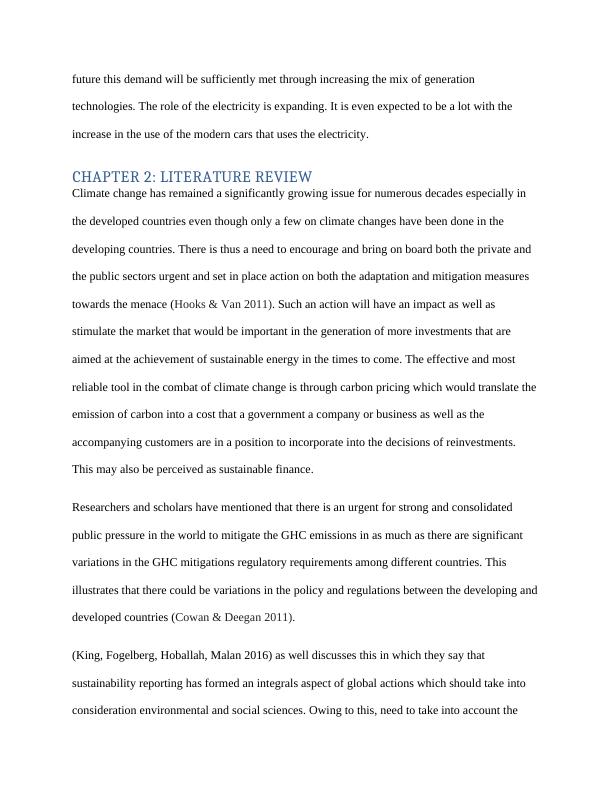
policies, standards, relaxations and other instruments arise as well as the need to encourage
organizations to be encouraged to report issues on climate change.
Going by statistics there has been recorded an increase in the consumption of household in New
Zealand with an increase in the income. Still, a shift has been observed in the consumer social
life percentages with a decade ranging between 2005 and 2015 (Albertini 2014). During this
period, there were a high number of households that had high amount of annual disposable
incomes that was to the tune of over IDR 120 million which is on average $10, 000 or IDR 10,
000, 000 per month. The approximation of the middle class of New Zealand which was
composed of income that ranged between IDR 36-120 million is also expected to expand or
attain 32 million household by the end of 2020. This would basically represent an upward growth
in the consumption (Chapple, Clarkson & Gold 2013).
This would in turn lead to an increase in the energy consumption for each of the household
product and hence a rise in the levels of carbon emissions. This would then translate to quite of a
challenge for reporting and disclosure of carbon emission which will at the end have an impact
on the cost of using energy. The main concern thus remains; will there be a reduction in the
carbon emission? Or should there be set in place strategy that can be used for carbon emission?
This remains a sensitive matter of fact that should be given the attention it deserves (Barbu et al.
2014).
The regulations for intention and drive to check on the activities on the environment or carbon
emissions have not properly been set and the guidelines for New Zealand more specifically in
such activities is only adopted by a few of the companies in the country. A company is only able
to generate a sustainability report if it has enough funding out of which from the more than 600
organizations to be encouraged to report issues on climate change.
Going by statistics there has been recorded an increase in the consumption of household in New
Zealand with an increase in the income. Still, a shift has been observed in the consumer social
life percentages with a decade ranging between 2005 and 2015 (Albertini 2014). During this
period, there were a high number of households that had high amount of annual disposable
incomes that was to the tune of over IDR 120 million which is on average $10, 000 or IDR 10,
000, 000 per month. The approximation of the middle class of New Zealand which was
composed of income that ranged between IDR 36-120 million is also expected to expand or
attain 32 million household by the end of 2020. This would basically represent an upward growth
in the consumption (Chapple, Clarkson & Gold 2013).
This would in turn lead to an increase in the energy consumption for each of the household
product and hence a rise in the levels of carbon emissions. This would then translate to quite of a
challenge for reporting and disclosure of carbon emission which will at the end have an impact
on the cost of using energy. The main concern thus remains; will there be a reduction in the
carbon emission? Or should there be set in place strategy that can be used for carbon emission?
This remains a sensitive matter of fact that should be given the attention it deserves (Barbu et al.
2014).
The regulations for intention and drive to check on the activities on the environment or carbon
emissions have not properly been set and the guidelines for New Zealand more specifically in
such activities is only adopted by a few of the companies in the country. A company is only able
to generate a sustainability report if it has enough funding out of which from the more than 600
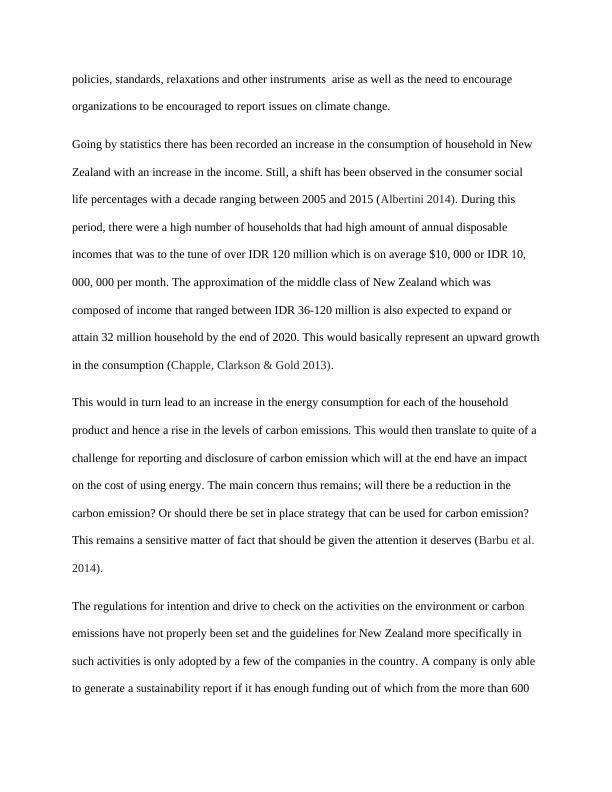
End of preview
Want to access all the pages? Upload your documents or become a member.
Related Documents
MGT723 Research Project PDFlg...
|7
|2056
|26
Social Disclosure and Its Accountability within the Malaysianlg...
|53
|13360
|75
Assignment Contemporary Issues in Accountinglg...
|14
|2524
|53
Auditing Theory and Practice: GHG Emission Disclosure and NGER Audit Requirementslg...
|12
|2828
|138
Board level responsibility for climate change lead to reduction in carbon emissionlg...
|16
|3387
|440
Carbon Disclosure in the Light of Legitimacy Theorylg...
|14
|2553
|333
